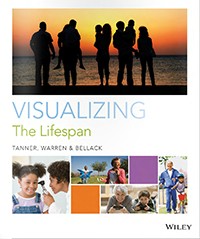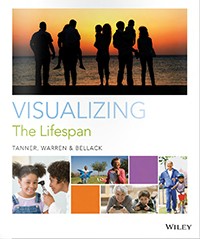This is completed downloadable of Test Bank for Visualizing The Lifespan 1st Edition by Tanner

Product Details:
- ISBN-10 : 0470917792
- ISBN-13 : 978-0470917794
- Author: Jennifer L. Tanner
Visualizing the Lifespan, Binder Ready Version will allow students to learn effectively by understanding the world around them and interpreting what they see in a meaningful and accurate way. The content, design, and layout of the title takes advantage of the full capacity in which students process information visual as well as verbal.
Table of Content:
- 1 Understanding Human Development: Theories and Approaches
- What Is Lifespan Human Development?
- The Developmental Perspective
- Key Issues of Human Development
- Theoretical Perspectives on Development
- The Scientific Method
- Theoretical Approaches
- Psychodynamic Perspectives
- Cognitive Perspectives
- Behavioral Perspectives and Social Learning
- Evolution-Based Perspectives
- Developmental Systems Theories
- Conducting Lifespan Research
- Research Methodology
- WHAT A DEVELOPMENTALIST SEES: Correlations
- Developmental Research Designs
- Ethical Issues
- WHERE DEVELOPMENTALISTS CLICK: Society for Research in Child Development
- 2 Biological Foundations, Prenatal Development, and Birth
- Genetics and Heredity
- What Is a Gene?
- Genetic Transmission
- Prenatal Development
- Reproductive Anatomy and the Process of Conception
- Stages of Prenatal Development
- Sensitive and Critical Periods
- Teratogens
- Genetic and Chromosomal Abnormalities
- WHERE DEVELOPMENTALISTS CLICK: Genetic Counseling
- Prenatal Care and Monitoring
- The Transition to Parenthood
- Labor and Birth
- Stages of Labor
- Childbirth Variations
- The Newborn and Postpartum Adjustment
- Medical and Behavioral Assessment of Newborns
- WHAT A DEVELOPMENTALIST SEES: Neonatal Assessment Using the Apgar Scale
- Low-Birth-Weight (LBW) and Very Low-Birth-Weight (VLBW) Infants
- Postpartum Adjustment
- 3 Physical and Cognitive Development in Infancy: The First Two Years
- Physical Development
- Growth Patterns
- The Nervous System
- The Skeletal System
- The Muscular System
- Cognitive Development
- Piaget’s Sensorimotor Stage
- Memory
- Language Development
- All the Systems Working Together
- Sensation
- WHERE DEVELOPMENTALISTS CLICK: The National Institute on Deafness and Other Communication Disorders
- Perception
- Health and Well-Being
- Nutrition
- CHALLENGES IN DEVELOPMENT: Malnutrition
- Sleep
- WHAT A DEVELOPMENTALIST SEES: Safe Cosleeping
- 4 Socioemotional Development in Infancy: The First Two Years
- Personality Development
- The Psychodynamic Perspective
- Temperament
- Social Influences
- Attachment
- WHAT A DEVELOPMENTALIST SEES: Attachment Styles and Associated Behavior
- CHALLENGES IN DEVELOPMENT: Failure to Thrive
- Gender
- Emotional Development
- Early Emotions
- Social Referencing and Self-Awareness
- 5 Physical and Cognitive Development in Early Childhood: Two to Six Years
- Physical Development
- The Nervous System
- The Skeletal System
- The Muscular System
- Cognitive Development
- Piaget’s Preoperational Stage
- Vygotsky’s Theory of Cognitive Development
- Information-Processing Perspective
- Language Development
- All the Systems Working Together
- Play
- Early-Childhood Education
- Common Health and Safety Concerns of Early Childhood
- WHERE DEVELOPMENTALISTS CLICK: Childstate.gov
- CHALLENGES IN DEVELOPMENT: Unintentional Injury
- WHAT A DEVELOPMENTALIST SEES: Preventing Injuries at Home
- 6 Socioemotional Development in Early Childhood: Two to Six Years
- Personality Development
- A Biological Perspective
- WHERE DEVELOPMENTALISTS CLICK: GeneWatch UK
- Behavioral and Social-Cognitive Perspectives
- A Psychodynamic Perspective
- Development of Self-Understanding
- Social Influences
- Parenting
- Nonparental Childcare
- CHALLENGES IN DEVELOPMENT: Child Maltreatment
- WHAT A DEVELOPMENTALIST SEES: Evaluating the Quality of Center-based Care
- Media Exposure
- Gender
- Emotional Development
- Developing a Vocabulary to Describe Emotions
- Regulating Emotions
- Emotions and Early Moral Development
- 7 Physical and Cognitive Development in Middleand Late Childhood: Six to Eleven Years
- Physical Development
- The Nervous System
- The Skeletal System
- The Muscular System
- Cognitive Development
- Piaget’s Concrete Operational Stage
- The Social Basis of Cognitive Development: From Vygotsky to Now
- Information-Processing Perspective
- WHERE DEVELOPMENTALISTS CLICK: Technology-enhanced Scaffoldingin a Classroom Setting
- Intelligence
- Language Development
- All the Systems Working Together
- The Developmental Context of School
- Children with Special Learning Needs
- WHAT A DEVELOPMENTALIST SEES: Specific Learning Disorders
- CHALLENGES IN DEVELOPMENT: Attention-Deficit/Hyperactivity Disorder (ADHD)
- Physical Health and Well-Being
- 8 Socioemotional Development in Middle and Late Childhood: Six to Eleven Years
- Personality Development
- Development of the Self
- Moral Development
- A Psychodynamic Perspective
- Social Influences
- The Changing Role of Parents During Middle and Late Childhood
- CHALLENGES IN DEVELOPMENT: Growing Up in Poverty
- Effects of Divorce
- Sibling Relationships
- Peers
- WHERE DEVELOPMENTALISTS CLICK: Olweus Bullying Prevention Program
- Emotional Development
- Emotional Understanding
- Risk, Resilience, and Coping
- 9 Phsyical and Cognitive Development in Adolescence
- Physical Development
- Puberty
- The Nervous System
- The Skeletal System
- The Muscular System
- Cognitive Development
- Piaget’s Formal Operational Stage
- Adolescent Egocentrism
- Decisions and Risks
- All the Systems Working Together
- Positive Youth Development
- Adolescent Sexuality
- WHERE DEVELOPMENTALISTS CLICK: National Institute of Allergy and Infectious Disease
- WHAT A DEVELOPMENTALIST SEES: Preventing Teen Pregnancy
- Common Health Concerns of Adolescence
- CHALLENGES IN DEVELOPMENT: Bulimia Nervosa and Anorexia Nervosa
- 10 Socioemotional Development in Adolescence
- Personality Development
- Adolescence
- Identity in Adolescence
- Influences on Identity Development
- WHERE DEVELOPMENTALISTS CLICK: The Kinsey Institute
- Social Influences
- Secondary School
- Parents and Adolescents
- Peer Culture
- CHALLENGES IN DEVELOPMENT: Problematic Internet Use
- Romantic Relationships
- Emotional Development
- Emotion Regulation
- WHAT A DEVELOPMENTALIST SEES: Signs of Depression
- Depression
- Adolescent Suicide
- 11 Physical and Cognitive Development in Emergingand Young Adulthood
- Theory: The Transition to Adulthood
- Cultural Context of Adulthood
- Emerging Adulthood
- WHERE DEVELOPMENTALISTS CLICK: The Society for the Study of Emerging Adulthood (SSEA)
- Young Adulthood
- Physical Development
- Nervous System
- Skeletal System
- Muscular System
- Reproductive System
- CHALLENGES IN DEVELOPMENT: The Most Common Causes of Infertility
- Cognitive Development
- Cognitive Development in Adulthood
- Postformal Thought: Beyond Piaget
- WHAT A DEVELOPMENTALIST SEES: Creative Productivity
- Creativity
- All the Systems Working Together
- Health and Well-Being
- Mortality
- Psychiatric Disorders
- Health Behaviors
- Fitness
- 12 Socioemotional Development in Emerging and Young Adulthood
- Personality Development
- Personality Traits
- Psychosocial Development
- Personality Change
- Social Influences
- Family
- Friendships
- Romantic Relationships
- Marriage
- Parenthood
- Emotional Development
- Emotion Regulation
- WHAT A DEVELOPMENTALIST SEES: Cognitive Reappraisal in Action
- Coping with Stress
- Mental Health
- WHERE DEVELOPMENTALISTS CLICK: The Occupational Outlook Handbook (OOH)
- CHALLENGES IN DEVELOPMENT: Behind the Quarterlife Crisis
- 13 Physical and Cognitive Development in Middle Adulthood
- Physical Development
- The Nervous System
- The Skeletal System
- The Muscular System
- Skin and Hair
- The Senses
- Cognitive Development
- Cognitive Abilities
- WHAT A DEVELOPMENTALIST SEES: Fluid and Crystallized Intelligence
- Experiences and Goals
- Expertise
- All the Systems Working Together
- Weight, Exercise, and Nutrition
- WHERE DEVELOPMENTALISTS CLICK: What’s on My Plate?
- Reproductive Changes and Sexuality in Middle Adulthood
- Death and Disease in Middle Adulthood
- Midlife Health and Well-being
- CHALLENGES IN DEVELOPMENT: Heart Disease
- 14 Socioemotional Development in Adulthood
- Personality Development
- Personality in Midlife
- Psychosocial Development: Generativity Versus Stagnation
- Social Influences
- Family in Midlife
- Marriage in Midlife
- WHAT A DEVELOPMENTALIST SEES: Midlife Marital Biographies
- CHALLENGES IN DEVELOPMENT: Marital Help-seeking
- Parental Caregiving
- Relationships with Adult Siblings and Friends
- WHERE DEVELOPMENTALISTS CLICK: National Alliance for Caregiving
- Emotional Development
- Emotions in Midlife
- Well-being in Midlife
- Gender Roles in Midlife
- Careers in Midlife
- 15 Physical and Cognitive Development in the Later Years
- The Aging Process
- A Statistical Picture of Aging
- Theories of Physical Aging
- WHERE DEVELOPMENTALISTS CLICK: The National Institute on Aging
- Physical Development
- The Nervous System
- The Skeletal System
- The Muscular System
- Cognitive Changes
- Information-Processing Changes
- WHAT A DEVELOPMENTALIST SEES: Technology to Keep Older Adults Connected and Cognitively Sharp
- Wisdom
- All the Systems Working Together
- Sensation and Perception
- Health and Well-Being
- Dementia
- CHALLENGES IN DEVELOPMENT: Families of Alzheimer’s Patients
- 16 Socioemotional Development in the Later Years
- Personality Development
- Erikson’s Stage of Integrity Versus Despair
- The Aging Self
- Social Theories of Aging
- Social Development
- Work and Retirement
- Relationships
- WHAT A DEVELOPMENTALIST SEES: STIs in Later Adulthood
- Ageism and Its Ramifications
- CHALLENGES IN DEVELOPMENT: Elder Abuse
- Religion, Spirituality, and Aging
- Emotional Development
- Emotional Well-Being
- Living Arrangements
- Loneliness and Depression
- WHERE DEVELOPMENTALISTS CLICK: The CDC’s Healthy Aging Site
- 17 Death, Dying, and Grieving
- What Is Death?
- Defining Death
- Causes of Death
- The Right to Die
- WHERE DEVELOPMENTALISTS CLICK: WHO Global Health Observatory
- The Process of Death and Dying
- Understanding the Concept of Death
- The Work of Elisabeth Kübler-Ross
- Palliative and Hospice Care
- WHAT A DEVELOPMENTALIST SEES: Hospice Care
- Bereavement and Grief
- Normal and Complicated/Traumatic Grief
- CHALLENGES IN DEVELOPMENT: Coping with the Loss of a Child
- Bereavement and Mourning in a Cultural Context
- Appendix: Answers to Mid-chapter Questions and Self-Tests
- References
- Glossary
- Index
- EULA





